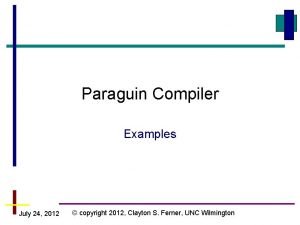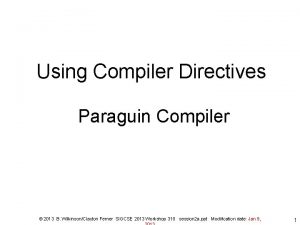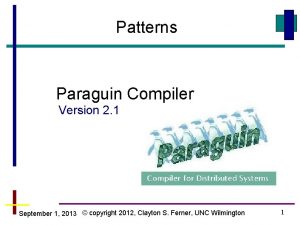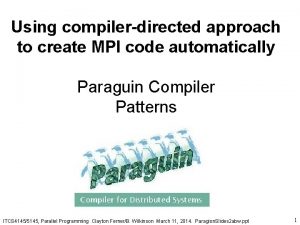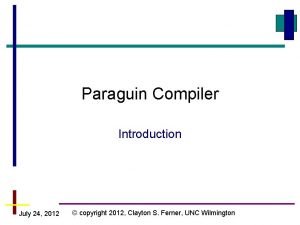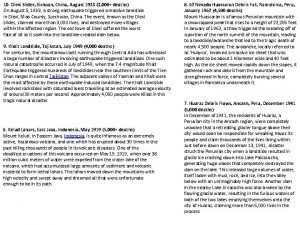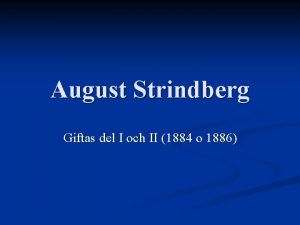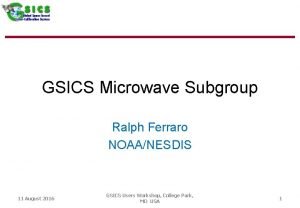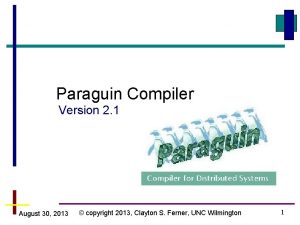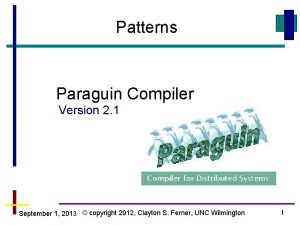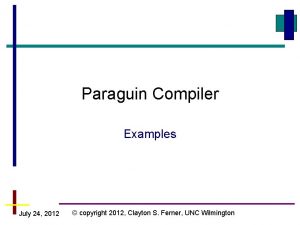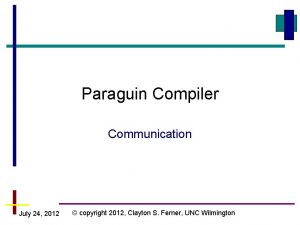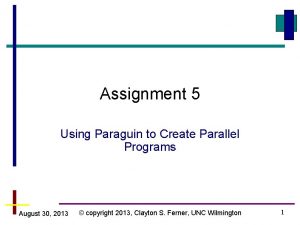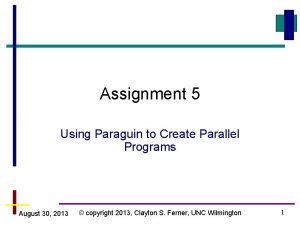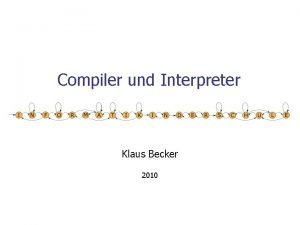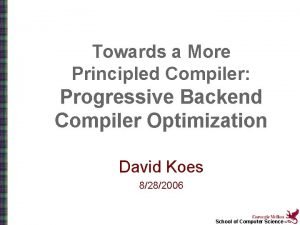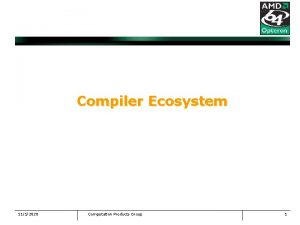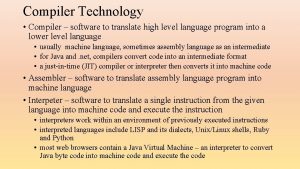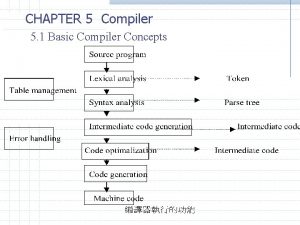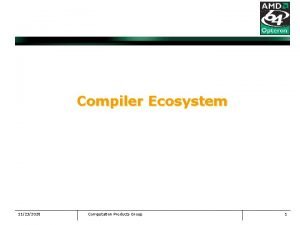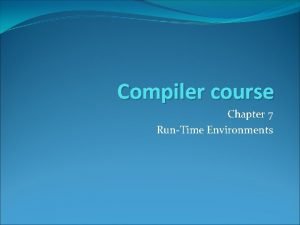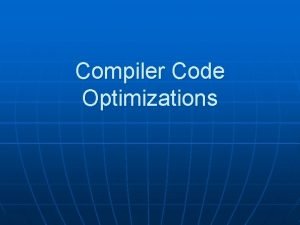Paraguin Compiler Version 2 1 August 30 2013
































![Broadcast int a, b[N][M], n; char *s = “hello world”; n = strlen(s) + Broadcast int a, b[N][M], n; char *s = “hello world”; n = strlen(s) +](https://slidetodoc.com/presentation_image_h2/f838ecb6ff6a8d2df5a64dfc9783a720/image-33.jpg)
![Broadcast int a, b[N][M], n; char *s = “hello world”; n = strlen(s) + Broadcast int a, b[N][M], n; char *s = “hello world”; n = strlen(s) +](https://slidetodoc.com/presentation_image_h2/f838ecb6ff6a8d2df5a64dfc9783a720/image-34.jpg)
![Broadcast int a, b[N][M], n; char *s = “hello world”; n = strlen(s) + Broadcast int a, b[N][M], n; char *s = “hello world”; n = strlen(s) +](https://slidetodoc.com/presentation_image_h2/f838ecb6ff6a8d2df5a64dfc9783a720/image-35.jpg)

![Scatter void f(int *A, int n) { int B[N]; … // Initialize B somehow Scatter void f(int *A, int n) { int B[N]; … // Initialize B somehow](https://slidetodoc.com/presentation_image_h2/f838ecb6ff6a8d2df5a64dfc9783a720/image-37.jpg)













- Slides: 50

Paraguin Compiler Version 2. 1 August 30, 2013 © copyright 2013, Clayton S. Ferner, UNC Wilmington 1

Introduction The Paraguin Compiler is a compiler that I am developing at UNCW (by myself basically) It is based on the SUIF Compiler infrastruction Using pragmas the user can direct the compiler (compiler directives) to produce and MPI program User Manual can be accessed at: http: //people. uncw. edu/cferner/Paraguin/userman. pdf August 30, 2013 © copyright 2013, Clayton S. Ferner, UNC Wilmington 2

SUIF Compiler System Created by the SUIF Compiler Group at Stanford (suif. stanford. edu) SUIF is an open source compiler intended to promote research in compiler technology Paraguin is built using the SUIF compiler August 30, 2013 © copyright 2013, Clayton S. Ferner, UNC Wilmington 3

Compiler Directives The Paraguin compiler is a source to source compiler It transforms a sequential program into a parallel program suitable for execution on a distributed-memory system The result is a parallel program with calls to MPI routines Parallelization is not automatic; but rather directed via pragmas August 30, 2013 © copyright 2013, Clayton S. Ferner, UNC Wilmington 4

Compiler Directives The advantage to using pragmas is that other compilers will ignore them You can provide information to Paraguin that is ignored by other compilers, say gcc You can create a hybrid program using pragmas for different compilers Syntax: #pragma paraguin <type> [<parameters>] August 30, 2013 © copyright 2013, Clayton S. Ferner, UNC Wilmington 5

Running a Parallel Program When your parallel program is run, you specify how many processors you want on the command line (or in a job submission file) Processes (1 per processor) will be given a rank, which is unique, in the range [0. . NP-1], where NP is the number of processors. Process 0 is considered to be the master. August 30, 2013 © copyright 2013, Clayton S. Ferner, UNC Wilmington 6

Parallel Region … #pragma paraguin begin_parallel … Code inside of the parallel region is executed by all processors #pragma paraguin end_parallel … August 30, 2013 Code outside of the parallel region is executed by the master process (with rank = 0) only. All other processors do not execute this code. © copyright 2013, Clayton S. Ferner, UNC Wilmington 7

Hello World #include <paraguin. h> #include <stdio. h> int __guin_rank = 0; int main(int argc, char *argv[]) { char hostname[256]; printf("Master process %d starting. n", __guin_rank); #pragma paraguin begin_parallel gethostname(hostname, 255); printf("Hello world from process %3 d on machine %s. n", __guin_rank, hostname); #pragma paraguin end_parallel } printf("Goodbye world from process %d. n", _guin_rank); 8

Explanation of Hello World #include <paraguin. h> The paraguin. h file needs to be the FIRST file included. It contains a couple of lines to deal with an incompatibility issue between the SUIF compiler and gcc. Don’t worry about it, but just put it into your program. August 30, 2013 © copyright 2013, Clayton S. Ferner, UNC Wilmington 9

Explanation of Hello World #include <paraguin. h> #include <stdio. h> int __guin_rank = 0; This is a predefined Paraguin identifier. We are allowed to declare it and even initialize it, but it should not be modified. int main(int argc, char *argv[]) { printf("Master thread %d starting. n", __guin_rank); … The reason for doing this is so that we can compile this program with gcc (with no modification to the source code) to create a sequential version of the program. August 30, 2013 © copyright 2013, Clayton S. Ferner, UNC Wilmington 10

Explanation of Hello World This defines a region to be executed by all processors. Outside of this region, only the master process executes the statements. #pragma paraguin begin_parallel gethostname(hostname, 255); printf("Hello world from process %3 d on machine %s. n", __guin_rank, hostname); #pragma paraguin end_parallel August 30, 2013 © copyright 2013, Clayton S. Ferner, UNC Wilmington 11

Explanation of Hello World Only the master process (with rank = 0) executes the code outside a parallel region. The other processors skip it. PE 0 PE 1 PE 2 PE 3 PE 4 PE 5 Execute printf("Master process %d starting. n", __guin_rank); Skip #pragma paraguin begin_parallel August 30, 2013 © copyright 2013, Clayton S. Ferner, UNC Wilmington 12

Explanation of Hello World Only the master process (with rank = 0) executes the code outside a parallel region. The other processors skip it. PE 0 PE 1 PE 2 PE 3 PE 4 PE 5 #pragma paraguin end_parallel Execute printf("Goodbye world from process %d. n", _guin_rank); Skip } August 30, 2013 © copyright 2013, Clayton S. Ferner, UNC Wilmington 13

Result of Hello World $ scc -DPARAGUIN -D__x 86_64__ -I/opt/openmpi/include/ -cc mpicc hello. World. c -o hello. World Compiling All on one line Running $ mpirun –np 8 hello. out Master process 0 starting. Hello world from process 0 on machine compute-1 -5. local. Goodbye world from process 0. Hello world from process 1 on machine compute-1 -5. local. Hello world from process 2 on machine compute-1 -5. local. Hello world from process 3 on machine compute-1 -5. local. Hello world from process 4 on machine compute-1 -1. local. Hello world from process 5 on machine compute-1 -1. local. Hello world from process 6 on machine compute-1 -1. local. Hello world from process 7 on machine compute-1 -1. local. August 30, 2013 © copyright 2013, Clayton S. Ferner, UNC Wilmington 14

Paraguin Compiler Submission Page Browse for a local source file Compile to source or executable August 30, 2013 © copyright 2013, Clayton S. Ferner, UNC Wilmington 15

Paraguin Compiler Submission Page Zip file contains: • File with Error/Warning Messages • Resulting MPI Source file only if successful Cleaning up will prevent the same files from being included in futures downloads. August 30, 2013 © copyright 2013, Clayton S. Ferner, UNC Wilmington 16

Notes on pragmas Many times you need an extra semicolon (; ) in front of the pragma statements. The reason is to insert a NOOP instruction into the code to which the pragmas are attached SUIF attaches the pragmas to the last instruction, which may be deeply nested. This makes it difficult for Paraguin to find the pragmas Solution: insert a semicolon on a line by itself before a block of pragma statements August 30, 2013 © copyright 2013, Clayton S. Ferner, UNC Wilmington 17

Incorrect Location of Pragma for (i = 0; i < n; i++) for (j = 0; j < n; j++) a[i][j] = 0; } } #pragma paraguin begin_parallel This code Actually appears like this: for (i = 0; i < n; i++) for (j = 0; j < n; j++) a[i][j] = 0; #pragma paraguin begin_parallel } } August 30, 2013 © copyright 2013, Clayton S. Ferner, UNC Wilmington 18

Solution for (i = 0; i < n; i++) for (j = 0; j < n; j++) Solution: put a semicolon in front a[i][j] = 0; of pragma } } ; #pragma paraguin begin_parallel Usually, it is needed after a nesting (e. x. for loop nest, while loop nest, etc. ) August 30, 2013 © copyright 2013, Clayton S. Ferner, UNC Wilmington 19

More on Parallel Regions The parallel region pragmas must be at the int f () topmost nesting within a function. { #pragma paraguin begin_parallel … #pragma paraguin end_parallel } int g() { #pragma paraguin begin_parallel. . . if (a < b) #pragma paraguin end_parallel August 30, 2013 This is an error © copyright 2013, Clayton S. Ferner, UNC Wilmington 20

Parallel Regions Related to Functions int f () { … } If a function is to be executed in parallel, it must either have NO Paraguin pragmas or it must have a parallel region. The call must be within a parallel region. int main() { #pragma paraguin begin_parallel f(); This one will execute in parallel #pragma paraguin end_parallel f(); August 30, 2013 This one will execute sequentially, regardless of its own parallel regions. © copyright 2013, Clayton S. Ferner, UNC Wilmington 21

Initializations of variables are executable statements (as opposed to the declaration) Therefore, then need to be within a parallel region a will be initialized on the master only because it is int f () outside a parallel region { int a = 23, b; #pragma paraguin begin_parallel b = 46; b will be initialized on … all processors #pragma paraguin end_parallel } August 30, 2013 © copyright 2013, Clayton S. Ferner, UNC Wilmington 22

Parallel Constructs All of these must be within a parallel region (some would deadlock if not): #pragma paraguin barrier #pragma paraguin forall #pragma paraguin bcast #pragma paraguin scatter #pragma paraguin gather #pragma paraguin reduce August 30, 2013 © copyright 2013, Clayton S. Ferner, UNC Wilmington 23

Barrier A barrier is a point at which all processors stop until they all arrive at the same point, after which they may proceed It’s like a rendezvous PE 0 August 30, 2013 PE 1 PE 2 PE 3 PE 4 © copyright 2013, Clayton S. Ferner, UNC Wilmington PE 5 24

Barrier … #pragma paraguin barrier … August 30, 2013 © copyright 2013, Clayton S. Ferner, UNC Wilmington 25

Parallel For (or forall) To execute a for loop in parallel: #pragma paraguin forall [chunksize] Each processor will execute a different partition of the iterations (call the iteration space) The partitions will be no larger than chunksize number of iterations Default chunksize Where n is the number of iterations and NP is the number of processors August 30, 2013 © copyright 2013, Clayton S. Ferner, UNC Wilmington 26

Parallel For (or forall) For example consider: #pragma paraguin forall for (i = 0; i < n; i++) { <body> Suppose n = 13. The iteration space is August 30, 2013 i=0 i=1 i=2 i=3 i=5 i=6 i=7 i=8 i=4 i=9 i=10 i=11 i=12 © copyright 2013, Clayton S. Ferner, UNC Wilmington 27

Parallel For (or forall) Also suppose we have 4 processors. Default chunksize is The iteration space will be executed by the 4 processors as: PE 0 i=1 i=2 PE 1 i=4 i=5 i=6 PE 2 i=8 i=9 i=10 PE 3 i=12 - i=3 i=7 i=11 - August 30, 2013 © copyright 2013, Clayton S. Ferner, UNC Wilmington 28

Parallel For (other notes) Note that the for loop that is executed as a forall must be a simple for loop: The increment must be positive 1 (and the upper bound must be greater than the lower bound) The loop termination must use either < or <= A nested for loop can be a forall: for (i = 0; i < n; i++) { #pragma paraguin forall for (j = 0; j < n; j++) { However, foralls cannot be nested August 30, 2013 © copyright 2013, Clayton S. Ferner, UNC Wilmington 29

How to transform for loops to simple for loops Count down loop #pragma paraguin forall for (tmp = 0; tmp < n; tmp++) { for (i = n-1; i >=0; i--) { … Nested loops for (i = 0; i < n; i++) { for (j = 0; j < n; j++) { … i = n – tmp – 1; … #pragma paraguin forall for (tmp = 0; tmp < n*n; tmp++) { i = tmp / n; j = tmp % n; … August 30, 2013 © copyright 2013, Clayton S. Ferner, UNC Wilmington 30

Parallel For (other notes) If the user provides a chunksize, then each processor cycles through chunksize iterations in a cyclic fashion Specifying a chunksize of 1 is cyclic scheduling (better load balancing) PE 0 i=4 i=8 PE 1 i=5 i=9 PE 2 i=6 i=10 PE 3 i=7 i=11 i=12 - - - August 30, 2013 © copyright 2013, Clayton S. Ferner, UNC Wilmington 31

Broadcast Broadcasting data sends the same data to all processor from the master #pragma paraguin bcast <list of variables> Broadcast is likely to be faster than individual message int a, b[N][M], n; char *s = “hello world”; n = strlen(s) + 1; #pragma paraguin begin_parallel #pragma paraguin bcast a b n s( n ) August 30, 2013 © copyright 2013, Clayton S. Ferner, UNC Wilmington 32
![Broadcast int a bNM n char s hello world n strlens Broadcast int a, b[N][M], n; char *s = “hello world”; n = strlen(s) +](https://slidetodoc.com/presentation_image_h2/f838ecb6ff6a8d2df5a64dfc9783a720/image-33.jpg)
Broadcast int a, b[N][M], n; char *s = “hello world”; n = strlen(s) + 1; #pragma paraguin begin_parallel #pragma paraguin bcast a b n s( n ) Variable a is a scalar and b is an array, but the correct number of bytes are broadcast N*M*sizeof(int) bytes are broadcast for variable b. August 30, 2013 © copyright 2013, Clayton S. Ferner, UNC Wilmington 33
![Broadcast int a bNM n char s hello world n strlens Broadcast int a, b[N][M], n; char *s = “hello world”; n = strlen(s) +](https://slidetodoc.com/presentation_image_h2/f838ecb6ff6a8d2df5a64dfc9783a720/image-34.jpg)
Broadcast int a, b[N][M], n; char *s = “hello world”; n = strlen(s) + 1; #pragma paraguin begin_parallel #pragma paraguin bcast a b n s( n ) Variable s is a string or a pointer. There is no way to know how big the data actually is Pointers require a size (such as s( n )) If the size is not given then only one character will be broadcast August 30, 2013 © copyright 2013, Clayton S. Ferner, UNC Wilmington 34
![Broadcast int a bNM n char s hello world n strlens Broadcast int a, b[N][M], n; char *s = “hello world”; n = strlen(s) +](https://slidetodoc.com/presentation_image_h2/f838ecb6ff6a8d2df5a64dfc9783a720/image-35.jpg)
Broadcast int a, b[N][M], n; char *s = “hello world”; n = strlen(s) + 1; #pragma paraguin begin_parallel #pragma paraguin bcast a b n s( n ) Notice that s and n are initialize on the master only 1 is added to strlen(s) to include null character Variable n must be broadcast BEFORE variable s Put spaces between parentheses and size (e. g. ( n )) August 30, 2013 © copyright 2013, Clayton S. Ferner, UNC Wilmington 35

Scatter Scattering data divides up data that resides on the master among the other processors #pragma paraguin scatter <list of variables> August 30, 2013 © copyright 2013, Clayton S. Ferner, UNC Wilmington 36
![Scatter void fint A int n int BN Initialize B somehow Scatter void f(int *A, int n) { int B[N]; … // Initialize B somehow](https://slidetodoc.com/presentation_image_h2/f838ecb6ff6a8d2df5a64dfc9783a720/image-37.jpg)
Scatter void f(int *A, int n) { int B[N]; … // Initialize B somehow #pragma paraguin begin_parallel #pragma paraguin scatter A( n ) B. . . Same thing applies for pointers with scatter as with broadcast. The size must be given. Only arrays should be scatter (it makes no sense to scatter a scalar). August 30, 2013 © copyright 2013, Clayton S. Ferner, UNC Wilmington 37

Scatter The default chunksize is where N is the number of rows and NP is the number of processors Notice that the rows are scattered, not columns User defined chunksize is not yet implemented August 30, 2013 © copyright 2013, Clayton S. Ferner, UNC Wilmington 38

MPI_Scatter The MPI_Scatter copies the parts into the beginning of the receive buffer is different that the send buffer August 30, 2013 © copyright 2013, Clayton S. Ferner, UNC Wilmington 39

Gather works just like Scatter except that the data moves in the opposite direction #pragma paraguin gather <list of variables> August 30, 2013 © copyright 2013, Clayton S. Ferner, UNC Wilmington 40

Gather is the collection of partial results back to the master The default chunksize is where N is the number of rows and NP is the number of processors User defined chunksize is not yet implemented August 30, 2013 © copyright 2013, Clayton S. Ferner, UNC Wilmington 41

Reduction A reduction is when a binary commutative operator is applied to a collection of values producing a single value #pragma paraguin reduce <op> <source> <result> Where <op> is the operator <source> is the variable with the data to be reduced <result> is the variable that will hold the answer August 30, 2013 © copyright 2013, Clayton S. Ferner, UNC Wilmington 42

Reduction For example, applying summation to the following values: 83 40 23 85 90 2 74 68 51 33 Produces the single value of 549 MPI does not specify how reduction should be implemented; however, … August 30, 2013 © copyright 2013, Clayton S. Ferner, UNC Wilmington 43

Reduction August 30, 2013 A reduction could be implemented fairly efficiently on multiple processor using a tree In which case the time is O(log(NP)) © copyright 2013, Clayton S. Ferner, UNC Wilmington 44

Reduction Available operators that can be used in a reduction: Operator Description max Maximum lor Logical or min Minimum bor Bitwise or sum Summation lxor Logical exclusive or prod Product bxor Bitwise exclusive or land Logical and maxloc Maximum and location Band Bitwise and minloc Minimum and location August 30, 2013 © copyright 2013, Clayton S. Ferner, UNC Wilmington 45

Reduction double c, result_c; . . . #pragma paraguin begin_parallel. . . // Each processor assigns some value to the variable c. . . #pragma paraguin reduce sum c result_c // The variable result_c on the master now holds the result // of summing the values of the variable c on all the // processors. . . August 30, 2013 © copyright 2013, Clayton S. Ferner, UNC Wilmington 46

Reducing an Array When a reduction is applied to an array, the corresponding values in the same relative position in the array are reduced across processors double c[N], result_c[N]; . . . #pragma paraguin begin_parallel. . . // Each processor assigns N values to the array c. . . #pragma paraguin reduce sum c result_c. . . August 30, 2013 © copyright 2013, Clayton S. Ferner, UNC Wilmington 47

Reducing an Array August 30, 2013 © copyright 2013, Clayton S. Ferner, UNC Wilmington 48

Next Topic Patterns: Scatter/Gather Stencil August 30, 2013 © copyright 2013, Clayton S. Ferner, UNC Wilmington 49

Questions? August 30, 2013 © copyright 2013, Clayton S. Ferner, UNC Wilmington 50
 Cross compiler in compiler design
Cross compiler in compiler design Yet another compiler compiler
Yet another compiler compiler Paraguin
Paraguin Paraguin
Paraguin Paraguin
Paraguin Paraguin
Paraguin Paraguin
Paraguin August kekulé
August kekulé Diexi slides, sichuan, china, august 1933
Diexi slides, sichuan, china, august 1933 August stern
August stern Dr lorraine johnstone
Dr lorraine johnstone August strindberg faderen analyse
August strindberg faderen analyse Central place theory
Central place theory Teori august weismann
Teori august weismann Povjestice postolar i vrag
Povjestice postolar i vrag Julie august
Julie august 6 months before august 31
6 months before august 31 Longest rivers in china
Longest rivers in china Mirjam nilsson
Mirjam nilsson August strindberg fruar
August strindberg fruar Fences character analysis
Fences character analysis August de prima porta
August de prima porta Diane august
Diane august August leyweg 4
August leyweg 4 Bagaimana pro dan kontra antara lamarck dengan darwin
Bagaimana pro dan kontra antara lamarck dengan darwin 2003 august 25
2003 august 25 August safety
August safety What happened on august 23 1939
What happened on august 23 1939 Ano ang pangyayari sa agosto 30 1896
Ano ang pangyayari sa agosto 30 1896 August lec 250
August lec 250 August hlond przepowiednie
August hlond przepowiednie Chinese names and pronunciation
Chinese names and pronunciation Monday august 26
Monday august 26 August šenoa povjestice
August šenoa povjestice It was late summer 26 august 1910
It was late summer 26 august 1910 August robert ludwig macke
August robert ludwig macke Mirjam nilsson contoso
Mirjam nilsson contoso August 26 2010
August 26 2010 Micro computer services began operations on august 1
Micro computer services began operations on august 1 Gottfried august bürger
Gottfried august bürger August strindberg giftas
August strindberg giftas Define testimonial propaganda
Define testimonial propaganda How old is madonna
How old is madonna August alsina testimony zip download
August alsina testimony zip download August wilson
August wilson When did michael jackson die
When did michael jackson die Dr ralph ferraro
Dr ralph ferraro August 27 2002
August 27 2002 Cnn 10 september 7th
Cnn 10 september 7th August kiss
August kiss Fences central idea
Fences central idea


